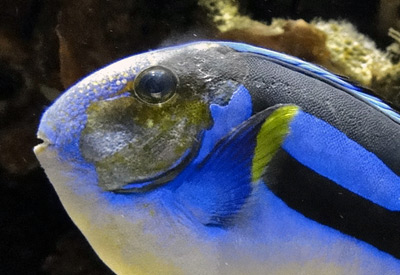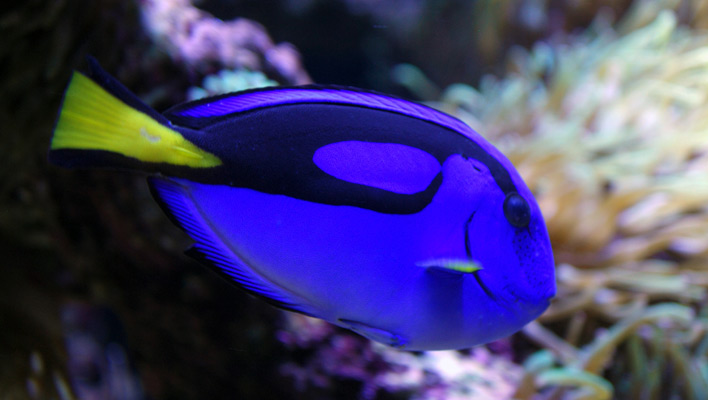Its common names include the Pacific blue tang, regal tang, hippo tang, palette surgeonfish, yellow-tail blue tang, and probably several others that presently elude me. Kids know it as the addle-brained Dory from Finding Nemo. Whatever common name you apply to it, though, Paracanthurus hepatus is one gorgeous blue fish!
Morphologically speaking, P. hepatus is highly laterally compressed (flattened from side to side) and possesses a sharp, retractable spine on each side of the caudal peduncle. It lacks the elongated snout common to so many surgeons, giving its face a somewhat more rounded profile.
Color-wise, this surgeon really makes a statement! It’s blue overall with a starkly contrasting bright-yellow tail and a black pattern on its flanks resembling a painter’s palette (hence one of its many common names).
However, despite its widespread familiarity and stunning good looks, P. hepatus is not among the easiest species to keep in aquariums—and it’s most decidedly not an appropriate choice for a youngster’s “Nemo” tank. More experienced hobbyists, on the other hand, can succeed with this species provided no shortcuts are taken in its care. Here’s how:
Start with a healthy specimen
 Look for a healthy-looking, robust-bodied (not pinched-in or emaciated-looking) specimen with no obvious signs of disease. P. hepatus seems to be highly susceptible to marine ich (Cryptocaryon irritans) and other ectoparasites as well as head and lateral line erosion (HLLE), so avoid purchasing any specimen that exhibits tell-tale symptoms such as:
Look for a healthy-looking, robust-bodied (not pinched-in or emaciated-looking) specimen with no obvious signs of disease. P. hepatus seems to be highly susceptible to marine ich (Cryptocaryon irritans) and other ectoparasites as well as head and lateral line erosion (HLLE), so avoid purchasing any specimen that exhibits tell-tale symptoms such as:
- White spots or specks
- Velvety sheen
- Excessive mucus production
- Repeatedly scraping on objects in the tank
- Pits, holes, or lesions on the head and/or along the lateral line
Feed properly
We tend to think of tangs as dedicated herbivores, but P. hepatus is one of the exceptions. It does require greens, but its natural diet consists primarily of zooplankton. Thus, its captive menu should include small, meaty foods of marine origin offered several times throughout the day and supplemented with various algae-based foods. If your specimen will also accept a high-quality pellet food, so much the better.
Remember: variety and nutritional balance are definitely the spice of life—and source of good health—for this species so it’s important to avoid falling into lazy feeding habits, such as relying too heavily on one food item. Be sure to mix it up!
Give it room
P. hepatus can reach approximately a foot in total length, so a large tank is in order. I wouldn’t go any smaller than 125 gallons, and the bigger, the better. Also, make sure the aquascaping provides plenty of open swimming space as well as ample hiding places.
Provide robust current and exceptional water quality
Highly oxygenated, briskly circulating water is a must for P. hepatus. Also, dissolved pollutants must be kept to a bare minimum through vigorous protein skimming and frequent partial water changes.
Choose tankmates wisely
P. hepatus usually won’t initiate squabbles with tankmates, possible exceptions being conspecifics and closely related surgeons. It can, however, be bullied by more aggressive fishes, so it’s best to select other peaceful species as tankmates.
This species is also generally well-behaved around sessile invertebrates, so it makes an excellent candidate for inclusion in large reef systems.




Hi. Mine looks very good. Bright colors quick swimmer. But… gletting bigger. Should be about 10 centimeters now. Chases other fish and eats quickly and agressively everything! Kind of not leaving anything for the tank mates. I was just told that she will become carnivouros and she will start to eat my corals! Quite a frightening thought! Is that right? Thanks a lot for your help.
Thank you.
It’s one fish we all are in love with. For me I like the aqua blue/cyan color tone that is seen with camera flashes and sun/daylight.
By the way, we talk of big gallon tanks in connection with tangs, etc.A 125 gal could also mean one with a lot of height and short length and even shorter depth/width/breadth.
So, I think a mention of the tank dimensions is more useful but of course we are talking of experienced keeprs here.
Ah, that’s an excellent point, Ayaan! The footprint of the tank is definitely an important consideration for P. hepatus.The longer and wider the better for this blue beauty!
As was said, they can grow to about a foot long (usually about 10″) but if you keep them in a smaller tank, they will live but will be stunted. Also as Jeff said they are very vulnerable to HLLE and almost always get it in my tank even though they live longer than ten years. No one is quite sure what causes HLLE or Head and lateral line disease as so many things have been sited from carbon fines to stray electricity to nitrates, to virus to rap music. The only thing that is certain is that confinement in a tank causes it as they do not get it in the sea. I have almost always had one in my reef and they are one of the most beautiful fish there is and one of the fed blue fish. A really nice blue with a “modern” painting on their sides.
The last one I kept for many years in my 100 gallon reef only grew to about 5″